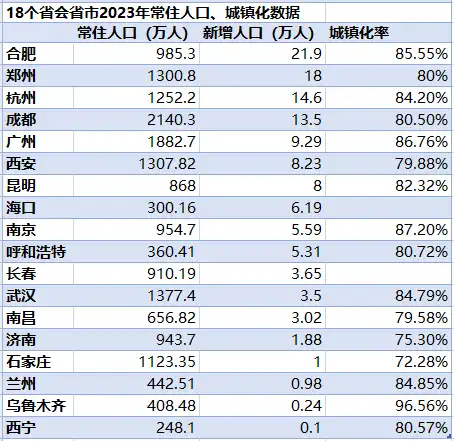The siphoning population in provincial capitals shows a double-edged sword of urbanization
2024.0409

Number of words in this article:1866, the reading time was about 3 minutes
introduction :陈井安向第一财经表示,城镇化率大幅增加是一柄双刃剑,中国的人口空间布局不能像国外那样,少数农民是养不活这么多的城市人口的,而且城市的产业和公共服务的承载力也承受不了那么多人口。
** Author| ** First Finance and Economics Li Xiuzhong
The expansion of provincial capitals continues.
On April 8, Xi'an and Zhengzhou issued statistical bulletins on national economic and social development. The two cities added 82,300 and 180,000 permanent residents respectively last year. The day before, Kunming also released a population data bulletin, showing that Kunming will increase its permanent population by 80,000 in 2023 compared with the previous year.
So far, 18 of the 27 provincial capitals (capital cities) have released population data for last year. Amid negative population growth across the country and a decline in the population of some provincial capitals, all permanent residents of these 18 cities achieved positive growth last year, and the population of 18 cities increased by more than 1.2 million.
Provincial capital cities accelerate population absorption
In the past 10 years or so, while population has continued to flow to developed areas along the southeast coast, gathering nearby provincial capital cities within the province has become the most prominent feature. According to the "Seven People's Survey" data, the population of central cities in the eastern coastal areas and provincial capitals in the central and western regions has increased significantly.
Chen Jing 'an, president of the Sichuan Province Population Society and a researcher at the Sichuan Province Academy of Social Sciences, told First Finance and Economics that provincial capitals have more resources in industry and public services such as education and medical care, and can provide more employment opportunities and opportunities to obtain public services. Therefore, by attracting people from provinces to gather in provincial capitals, the siphon effect of provincial capitals will become more obvious.
At the same time, many provinces are also implementing the "Strengthening Provincial Capital" campaign, which has promoted the expansion of provincial capital. For example, Kunming clearly stated that by 2025, Kunming's urban population will reach 10 million, and the built-up area will reach 1000 square kilometers, entering the trillion GDP club; by 2035, the GDP will reach 2.7 trillion yuan.
According to the seven-person census data, from 2010 to 2020, there were 32 cities with a permanent population increase of more than 1 million, including 20 in the eastern coast and 12 in the central and western regions. Shenzhen, Guangzhou, Chengdu, Xi'an, Zhengzhou, Hangzhou, Chongqing, Changsha, Wuhan and Foshan have become the top ten cities with the largest population growth, of which 7 are provincial capitals.

After the epidemic, the population absorption of provincial capital cities is still accelerating. Among the 18 provincial capital cities that have been announced, Hefei, Zhengzhou, Hangzhou and Chengdu will all increase their permanent population by more than 100,000 in 2023, increasing by 219,000, 180,000, 149,000 and 135,000 respectively. In addition, Guangzhou, Xi'an and Kunming also increased by 92,900, 82,300 and 80,000 respectively, ranking among the top population growth levels.
Ding Jinhong, president of the Shanghai City Demographic Society and former dean of the School of Social Development of East China Normal University, said in an interview with First Finance and Economics that the population is now divided between cities, and the mobility within the province is relatively large. The long-term pattern in the future is that the provincial capital cities and dual-center cities in some provinces will maintain certain growth, and the population of other cities will continue to decline.
Increasing urbanization rate is a double-edged sword
While population agglomeration in provincial capitals is accelerating, the urbanization rate has also increased significantly.
In 2023, the urbanization rates of Chengdu and Zhengzhou will exceed 80%, reaching 80.5% and 80% respectively, an increase of 0.61 and 0.6 percentage points respectively over the previous year. Among the 18 provincial capitals, 13 cities have urbanization rates exceeding 80%. In addition, Xi'an's urbanization rate last year was 79.88%, and Nanchang's urbanization rate was 79.58%, both approaching 80%.
From a national perspective, the urbanization rate of the national permanent population at the end of 2023 will be 66.16%, an increase of 0.94 percentage points from the end of the previous year. The urbanization rate of provincial capital cities is generally more than 15 percentage points higher than that of the country. The urbanization rate in developed countries is generally above 80%, which means that the urbanization rate of provincial capital cities basically reaches the level of developed countries.
However, Chen Jing 'an told First Finance and Economics that the significant increase in urbanization rate is a double-edged sword. China's population spatial layout cannot be like that of foreign countries. A few farmers cannot support so many urban populations, and the city's industries and public services cannot bear so many people.
Among the 18 cities, Urumqi has the highest urbanization rate, reaching 96.56% last year, while Nanjing, Guangzhou and Hefei all exceeded 85%, reaching 87.20%, 86.76% and 85.55% respectively; Lanzhou, Wuhan, Hangzhou, Kunming, Hohhot, Xining, Chengdu and Zhengzhou were 84.85%, 84.79%, 84.20%, 82.32%, 80.72%, 80.57%, 80.50% and 80% respectively.
According to the current national urbanization rate, there is still much room for improvement in the future. Li Peilin, a member of the Chinese Academy of Social Sciences, wrote an article in 2022 that China's urbanization level will continue to improve and exceed the 75% ceiling. So, with an increase of nearly 10 percentage points, can these populations still gather in provincial capitals?
Chen Jing 'an said that the current large-scale agglomeration of population to provincial capitals is actually an imbalance. It is a siphon of provincial capitals to other areas, and the agglomeration speed is tending to intensify. It is now necessary to promote the integrated development of urban and rural areas. Each space should have an industrial and public service layout, and sub-central cities must also play a role in attracting more people.
In fact, in recent years, the urbanization rate of provincial capital cities has accelerated beyond expectations. According to Xi'an City's "14th Five-Year Plan", Xi'an expects the urbanization rate to reach 77% in 2025, but this figure was close to 80% last year. Chengdu City's "14th Five-Year Plan" proposes that the urbanization rate will reach 80% by 2025. This goal was completed last year.
Chen Jing 'an said that there is no standard for how high and reasonable the urbanization rate is. At the same time, we have not accumulated experience in this regard. This is related to the actual conditions of the city and is dynamically balanced. However, if the population gathers with an urbanization rate of more than 80%, the city's industries and public service facilities will face greater pressure.
**
